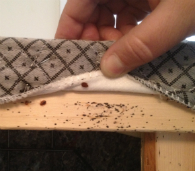Bed Bugs Austin TX : Big Choices
 Bed bugs have plagued humans for thousands of years. During most of the 20th century developed countries enjoyed a brief intermission from these pests. This intermission or break from bed bugs was largely caused by the invention and widespread use of DDT and synthetic organophosphates. Since then, the world has changed dramatically. DDT and synthetic organophosphates can peel chrome off a bumper so they are currently unavailable and have been banned and removed from markets around the world. So, Austin bed bugs are not familiar with these products. Now with our access to cheap, fast travel, and reports of pesticide resistance, we are seeing extreme bed bug resurgences. When it comes to bed bugs Austin TX is really feeling this resurgence. Austin bed bug customers are facing tough choices of how to proceed with a treatment. What type of bed bug treatment makes sense to you?
Bed bugs have plagued humans for thousands of years. During most of the 20th century developed countries enjoyed a brief intermission from these pests. This intermission or break from bed bugs was largely caused by the invention and widespread use of DDT and synthetic organophosphates. Since then, the world has changed dramatically. DDT and synthetic organophosphates can peel chrome off a bumper so they are currently unavailable and have been banned and removed from markets around the world. So, Austin bed bugs are not familiar with these products. Now with our access to cheap, fast travel, and reports of pesticide resistance, we are seeing extreme bed bug resurgences. When it comes to bed bugs Austin TX is really feeling this resurgence. Austin bed bug customers are facing tough choices of how to proceed with a treatment. What type of bed bug treatment makes sense to you?
As bed bug infestations grow nationwide, people are always looking for solutions. For Austin bed bug control there are more and more treatment options being developed every year. The real choice on the market today for bed bug Austin TX customers is a choice between applying traditional insecticides, or extreme temperatures. Traditional insecticides consist of a combination of liquid and dust products placed in all the cracks and crevices throughout the infested area. This type of chemical leaves behind a residual that will continue to treat for bed bugs for up to 60 days after the initial treatment. On the other hand, a heat treatment is green pest control. This type of treatment literally slowly heats up the room to a temperature that will kill all bed bugs. The idea behind this treatment is that the bugs will not notice the gradual increase in temperature. The temperature will eventually reach so high that it will get rid of bed bugs throughout the space. This is obviously a good treatment for a situation where people may be more sensitive to chemicals being used around them.
In places like hospitals, outpatient centers, nursing homes and school dormitories where health and chemical exposure are always a concern, treating with temperature is frequently a preferred choice. This is also true for many Austin pest control customers who tend to look for green pest control solutions. However, when trying to get rid of bed bugs this green pest control mindset Austin pest control customers have may not be the best solution.
Heat or extreme temperature can be an effective treatment method, but it does have a few drawl backs. While it is a green pest control approach towards getting rid of bed bugs, heat treatments do not leave behind any residual treatment. Their lack of residual treatment can be a pretty extreme drawback, especially in the aforementioned establishments where incoming pressure is a constant. In a hospital or nursing home people are coming in frequently. This constant traffic of tenants can be more of an issue than infestation. Also, most experts agree that as much as 60 percent of an infestation consists of the bed bug eggs that are left behind and will hatch later. Both these two issues are always a concern when treating for bed bugs. Another aspect to consider is the building. In Austin bed bugs hide in wall voids, I would bet this is also true for your city. Wall voids are filled with insulation. Insulation is designed to be resistant to temperature change. So are all the nooks and crannies reaching the temperatures that will get rid of bed bugs? Finally the heat treatment is generally a more expensive choice when compared to the traditional insecticide treatments available. They are both fairly expensive but the heat treatment generally carries a greater cost.
